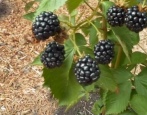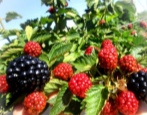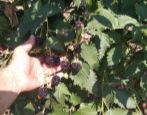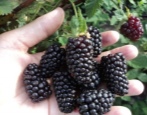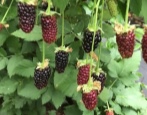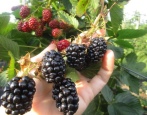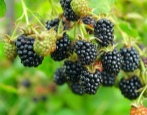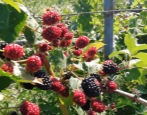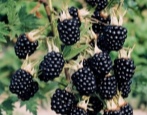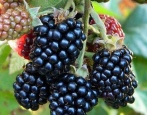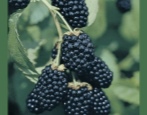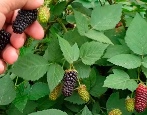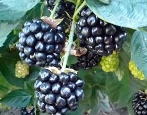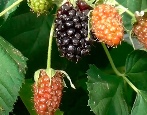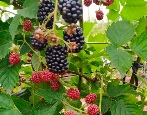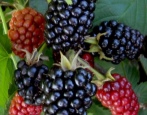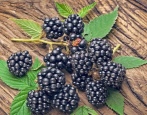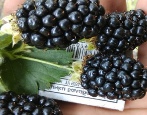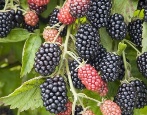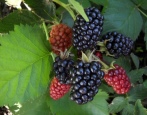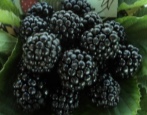
- Authors: Scotland, Dr. Jennings, Crop Research Institute
- Taste: sweet
- Scent : strong blackberry
- The presence of thorns: No
- Berry weight, g: up to 5
- Berry size: large
- Berry color: black-purple
- Fruiting period: from the second half of August and lasts until frost
- Yield: up to 15 kg per bush
- Frost resistance, ° C / Winter hardiness: winter hardy
Blackberries have recently become a berry that can be found on almost any personal plot. It is worth talking about the Loch Ness variety in more detail, since it is one of the most popular shrubs.
Breeding history of the variety
Loch Ness variety has appeared not so long ago. Its creator was Derek Jennings, who operates on the grounds of the Crop Research Institute in Scotland. Loch Ness was founded in 1990. The progenitors were raspberries and logan berries.
The doctor has identified a special gene in plants that is responsible for the scale of the berries. As it turned out, if you breed a hybrid based on this very gene, you can significantly increase the productivity of the bushes.
Description of the variety
Berries of this variety can be used in food both fresh and for creating various dishes and canning.
The bushes are semi-creeping, compact and neat-looking. If you do not do thinning in a timely manner, then you can soon observe a strong thickening.
Experience has shown that a larger yield can be achieved on moist, soddy-podzolic soil with a large amount of humus.
Description of the bush
If we talk about the crown, then it is in an adult plant, semi-vertical. There are no thorns on the branches, which is an undoubted advantage of the variety. The branches grow thick. Shoots can reach a height of 4 meters. They are erect below, and creeping at the top. It is for this reason that the gardener is required to either prune the shrub on time, or lay the branches on the trellis. Moreover, the maximum height of the bush can reach 150-180 cm.
Ripening terms
Fruits begin to be harvested from mid-August. The fruiting period lasts until the first frost. For this reason, Loch Ness is referred to as the middle ripening period.
Growing regions
Blackberries grow well in any region of our country. The variety is in great demand in Moscow and the Moscow region.
Yield
The variety is also praised by gardeners for its yield, with just one bush it is possible to collect up to 15 kg of ripe berries.
Berries and their taste
Loch Ness berries have juicy berries with firm pulp and a unique, strongly blackberry aroma. The weight of each reaches 5 g. If you harvest at the stage of technical ripeness, you cannot but appreciate the slight sourness that they possess. When the blackberries are fully ripe, they become sweet, sugary. The shape of the fruit is conical.
Inexperienced gardeners, due to the too black color of the berries, do not always understand when the fruits have reached technical ripeness, and when, indeed, it is time to pick them.
Growing features
Most gardeners talk about the unpretentiousness of the described blackberry variety. However, it is worth waiting for a big harvest only when enough attention is paid to the plant.
The soil should be fertile, moist and well-drained. The ideal pH is 5.5-6.5.
Blackberries of this species definitely need sunlight, so you should choose the appropriate place for planting.
In the first year after planting, nothing special is required from the gardener. It is enough to provide proper watering, loosen the soil around in time so that oxygen can freely penetrate to the roots.
It is worth remembering that when the root part located at the surface of the soil is damaged, thorns begin to form.For this reason, it is better to use a covering material between the bushes, which additionally inhibits the growth of weeds.
Site selection and soil preparation
Preparations for planting should begin in the spring. To do this, blackberries are looking for a sunny area where there is no draft. For each seedling, you will need to prepare a hole. Its dimensions are 40x40x40 cm. Loch Ness requires space around, therefore, an empty space of 1.5-2.5 meters is necessarily left between the seedlings. If the seedlings are planted in rows, then at least 2 meters are left between them.
Before immersing the seedling in the pit, a mixture of 5 kg of compost is placed in it; humus, 50 grams of potassium salt and 100 grams of superphosphate can be used. All this is mixed with the soil, then it is additionally covered with another layer of soil. If this is not done, then the root system is easy to burn on the fertilizer.
When planting, root buds are placed 4 centimeters below ground level. After planting, each bush is watered abundantly with water, and the surface around is covered with mulch. You can use straw or sawdust. After the work is done, the aboveground part of the plant should be shortened to 25 cm.
It is better at this stage to put a trellis next to each plant. It allows you to greatly simplify the process of caring for blackberries in the future. While the shoots are growing, they are attached to the support. It is very important to fasten the branches in a zigzag manner around the trellis.
Pruning
Pruning is done in the spring, usually in May. They remove not only the height of the shoots, but also the lateral growths in order to stimulate flowering.
The second pruning is done in the fall. It is necessary to remove sick and weak shoots from the bush. Those that have ceased to bear fruit are also pruned. After pruning, it is important to separate last year's branches and new ones.
If thinning is carried out, then only 4-6 branches are left per bush. The stumps are not left as they are a source of infection if they rot.
Watering and feeding
Blackberries do not need frequent watering, but they do not like stagnant water. Only young plantings require regular moistening of the soil, since water helps them take root faster and form greens. In this case, watering the plants is required at least once a week, and if there is a drought, then you can 2 times.
Adult bushes have enough water, they should be watered only if there has been no rain for a long time, and during the period when berries and flowers begin to form on the stems.
If the necessary nutrients were introduced into the hole during planting, then the next time feeding will be required only in the third year. In the spring, these are nitrogen-containing compounds. Urea is ideal because in the spring you need to help the plant grow foliage.
In summer, they prefer phosphorus and potassium, which have a positive effect on the taste and size of the berries.
In the fall, you can use complex fertilizers, which must contain iron, zinc, boron and other trace elements.
It is very useful to feed the plant with wood ash.
Reproduction
Loch Ness can be propagated by seeds, rooting the tops, planting green or lignified shoots, as well as dividing the bush.


